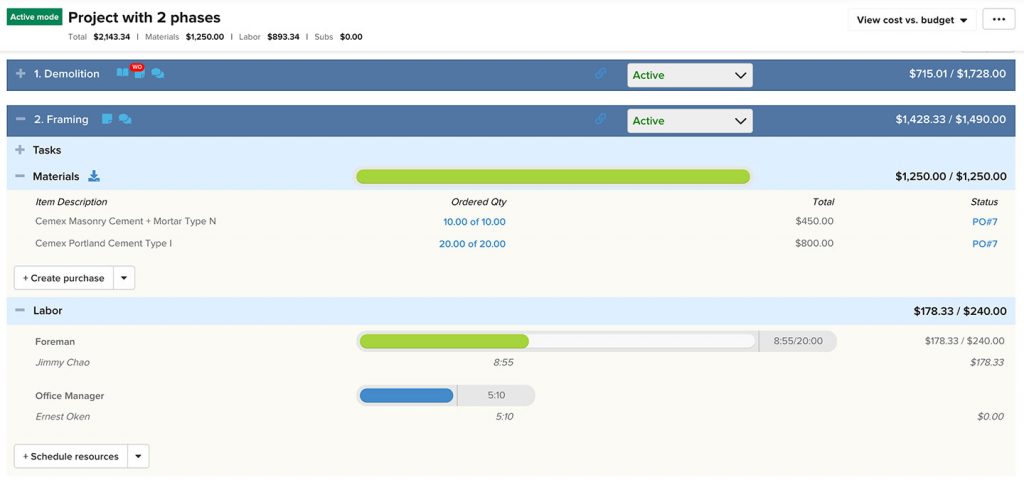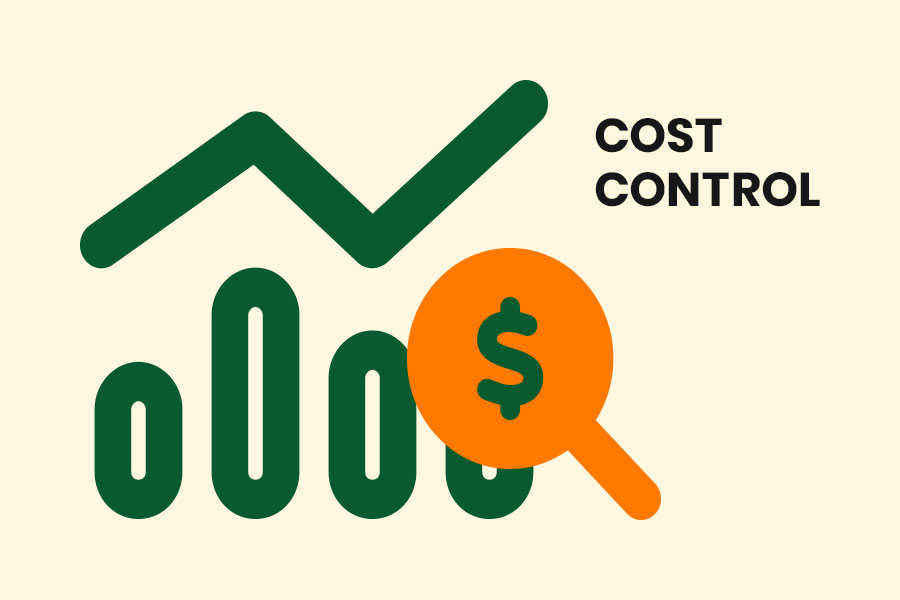Across the board, construction and contracting businesses are feeling the impacts of global supply chain disruptions and labor shortages firsthand. According to an early 2022 news release published by Associated Builders and Contractors, “overall construction input prices are up 22.3% from a year ago, while nonresidential construction input prices have increased 23.2% over that span.”
And with business owners trying to navigate these volatile economic waters, staying on track with your construction budget can feel overwhelming, if not impossible. Here are five strategies to improve cost control in your construction projects, and regain power over your construction budget.
What is cost control in construction?
Traditionally, cost control in construction refers to the ongoing process of managing costs– business expenses such as materials, labor, overhead, and change orders–associated with a project in order to improve profitability. The process of controlling costs helps project owners and managers deliver projects on time and on budget while increasing the revenue generated from that project.
There are multiple components to effective cost control. These include accurately estimating costs, carefully tracking expenses, and proactively identifying and mitigating potential budget overruns. In order to meet these requirements, project managers will need to create detailed budgets, build systems for tracking actual costs against budgeted costs, and have a feedback loop for adjusting cost management processes as needed.
Managing construction costs also involves optimizing resource allocation, especially as it relates to equipment and labor. Effective cost management practices also include negotiating favorable contracts and pricing with material suppliers and subcontractors.
Collaboration and consistent communication between architects, contractors, engineers, clients, and other project stakeholders is another key component of effective construction cost management.
Working closely in this way creates trust and supports data-driven decision-making through transparency. When everyone is in the same room with access to the same data, it leads to faster and better decisions that influence a project’s success.
Why cost control is important
Aside from increasing overall profitability, cost control in the construction industry is critical for building a successful construction business. By creating a strong reputation for completing jobs within the scope, project budget, and timelines initially outlined, your company is more likely to:
- Win future contracts
- Improve your bid-hit ratio
- Discover current processes that can improve
- Remain agile through unexpected challenges
Good project cost control can also contribute to the overall project’s success, outside of avoiding cost overruns. Cost control relies on detailed and accurate cost estimates and tracking throughout all construction project phases. This creates a natural sort of accountability and transparency that can build trust and strengthen relationships throughout the team. With financial matters, honesty and openness is the best policy.
There are environmental benefits to implementing cost control methods too. With a cost control process in place, your team is much more likely to avoid wasting materials, your equipment and other resources will be better allocated, and you’ll have the right mix of labor for the job.
When you use what you need to complete a job and nothing more, you cut down on waste, supporting sustainability and the growing emphasis on responsible construction practices.
Cost management goes hand in hand with project management. Projects that adhere to budgetary constraints through effective cost control are more likely to be completed on schedule. When financial aspects are managed well, projects are less susceptible to delays caused by funding shortages, unexpectedly high variable costs, or cash flow issues.
When thinking about the impact of cost control, it can be helpful to zoom out and look at the big picture. Some of the biggest benefits of cost control come into play when assessing the quality of the final build. If you manage costs diligently, you can invest your capital in the highest value areas like workforce safety measures, skilled labor, and high-quality materials without issue.
Sample cost control process
Subcontractors must effectively manage costs in construction projects to ensure success and maintain healthy profit margins. Here is a step-by-step cost control process tailored for them:
Step 1: Preliminary budgeting and estimation
Collaborate closely with the main contractor to establish project scope, goals, and budget constraints. Develop a detailed cost estimate for subcontracting tasks, considering the expected cost of materials, labor, equipment, and potential risks.
Step 2: Detailed cost breakdown
For better expense tracking, categorize costs into individual line items like materials, labor hours, equipment rentals, permits, and contingency funds.
Step 3: Cost tracking tools and systems
Use construction management software or spreadsheets to track construction project costs in real-time. Update reports regularly for an accurate financial overview.
Step 4: Regular expense monitoring
Regularly monitor expenses, compare them to estimated costs and take action if deviations occur.
Step 5: Document and communication
Keep accurate financial records and communicate effectively with contractors, suppliers, and your team. Keep stakeholders updated on costs, changes, and challenges.
Step 6: Variance analysis
Conduct regular variance analyses to compare estimated and actual costs. Determine root causes of cost variance and discrepancies and assess preventability. Use findings to address cost overruns.
Step 7: Change order management
When managing construction projects, it’s important to handle change orders effectively. Document any changes to the initial scope of work and their costs. Always obtain approval from the main contractor or project manager before implementing changes to prevent future disputes.
Step 8: Risk management and contingency
Maintain a contingency fund in case of unexpected expenses. Assess potential risks and adjust the budget accordingly. Regularly review and update the fund as the project progresses.
Step 9: Reporting and analysis
Produce periodic cost reports for the primary contractor or project lead. These reports should include the current financial status, actual expenses, and any discrepancies from the budget. Additionally, provide recommendations for cost-saving measures, address any challenges encountered, report on key performance indicators, and offer future projections.
Subcontractors can effectively manage expenses and maintain profitability by following this comprehensive cost control process. To ensure the best results, strive for clear communication, diligent tracking, and proactive problem-solving whenever possible.
Learn more about Knowify's budgeting, estimating, and cost monitoring tools
How to budget with cost control in mind
1. Keep material prices up to date
Construction material prices are in flux now more than ever, so keeping an eye on the market is crucial to staying within your budget. Outside of noticing changes in your current prices, keep an eye on your supplier’s competitors’ rates.
Don’t be afraid to negotiate and renegotiate, leveraging your relationships to improve your rates by requesting free delivery, seasonal pricing, and other discounts.
Another way to keep construction material prices low is to form a buying group and opt for wholesale purchases wherever possible. These strategies will give you greater control over pricing based on purchase quantity and frequency
2. Get your construction budget down to the line item
The more you break down a budget, the better you’ll become at controlling expenses. Take into consideration the exact prices of materials, labor, overhead, markup percentages, and more when creating each phase of your project.
This also provides intimate knowledge of each phase of the project and greatly reduces your chances of missing an important step or cost that could eat at your overall profitability. Additionally, by creating pre-budgeted line items, you’ll have greater control and confidence throughout the quoting process should clients have questions about their initial quote.
While it’s optional for you to choose to send a line item or lump sum quote, knowing how the quote breaks down is always an advantage for your team.
3. Build in contingency and allowances
With any project, there’s a degree of uncertainty as to the final cost and how smoothly things will go. Among many other roadblocks to account for, there’s the potential for price increases, errors in scope, incomplete designs, weather, and technology or mechanical complications that can easily drive project costs up.
And while advanced planning through allowances can go a long way, it’s best to have a financial cushion built into your construction budget. This is known as contingency, or an amount added into a construction quote that accounts for unpredictable and uncontrollable circumstances throughout the duration of your project.
While allowances are typically used to create flexibility in material selection or project scope at the onset of a project, contingency creates flexibility in time delays, malfunctions, and economic or market shifts. By including both allowances and contingencies in your initial contract and budget, you’ll increase profitability and remain more liquid throughout a project.
4. Increase budget visibility and participation
While sharing budgeting information with lower-level employees helps everyone stay within a designated budget, there are significant benefits to a style known as participative budgeting.
Participative budgeting is when lower levels of management, such as foreman or crew leads, have an influence on the creation of a budget – not just staying within an imposed budget. Direct benefits of participative budgeting include:
- More precision in creating budgets for each phase of a project
- Greater awareness of frequent challenges crew leads face
- Extra sets of eyes to catch errors or missing information
- Increased levels of ownership in foremen and workers
- Improved trust in business leaders by lower-level employees
Participative budgeting can come in many forms and you can implement it to varying degrees. The key is to find the sweet spot for gaining access to more information without slowing down processes too much.
5. Ditch the construction budget template in Excel
Aside from being time-consuming and challenging, using a construction budget template in Excel can be a massive risk. Each time a file is downloaded, there is the potential for outdated numbers and information to be passed on to others.
Unless a cloud-based system is employed and you can be sure nobody downloads their own offline version, they create opportunities for delays, overspending, and miscommunication.
The best way to avoid overspending and the spread of misinformation is to use cloud-based construction business management software. This allows your information to update in real-time, as well as increases your team’s accuracy and accountability.

Gain confidence in your project budgets
Improving cost control in your construction budgets doesn’t have to be an overwhelming task. While there are many ways to control costs and increase profitability, the first step is to understand where you currently stand and identify your greatest financial weaknesses. Utilizing business management software, like Knowify, can help you visualize areas of improvement, and, ultimately, set you on a path toward better cost control in your construction budgeting.
To learn more about how Knowify can help you with cost control and budgeting, schedule a demo with a Knowify expert, or start your free trial today!
Don’t let unexpected costs derail your projects
Schedule a demo today to meet a Knowify expert to see how you can stay on budget and maximize profits.
